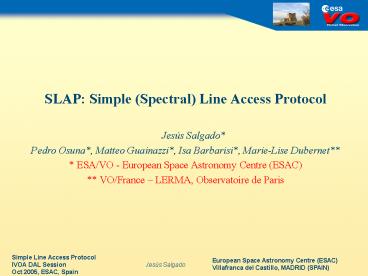SLAP: Simple (Spectral) Line Access Protocol PowerPoint PPT Presentation
1 / 12
Title: SLAP: Simple (Spectral) Line Access Protocol
1
- SLAP Simple (Spectral) Line Access Protocol
- Jesús Salgado
- Pedro Osuna, Matteo Guainazzi, Isa Barbarisi,
Marie-Lise Dubernet - ESA/VO - European Space Astronomy Centre (ESAC)
- VO/France LERMA, Observatoire de Paris
2
About Spectral Line Access
- There is a scientific need to have access to
spectral line databases in the VO. Many science
cases could make use of this kind of access - It was agreed in last interop meeting (Kyoto) to
start some work in this line - Three activities done in coordination. Line Data
Model document, Simple Line Access Protocol and
test implementation (both server and client
side) - A clear division was found since the very
beginning - Observational spectral line databases Lines
observed and identified in real spectra collected
by different instrument/projects. - Theoretical spectral line databases Servers
containing theoretical spectral lines will be
included in this group. - This division is quite similar to the one found
in spectral access.
3
Protocol Overview
- The approach followed by this protocol is the
same one as the successful SIAP protocol, only
diverging from it when the physics of the problem
force to do it. - But not a two step process!
- Some ideas of the access to Theoretical spectra
have been developed and used for Theoretical
Spectral Line databases. - Parallel to Line Data Model document, using it as
the source of the abstract representation of a
spectral line. - Basic search, lines in a wavelength range. Need
for extra parameters.
4
Present status
Many on-line spectral line search services
extensively used by scientists. All of the
services have different form panels.
Form Query Panel
Line Database
Form Query Panel
Client
Line Database
Form Query Panel
Line Database
5
SLAP Layer
A SIAP-like URL service, would allow an easy
implementation for all spectral line providers
Form Query Panel
SLAP Layer
Line Database
Client
SLAP Layer
Line Database
VOTable, one spectral line per row
Form Query Panel
SLAP Layer
Line Database
? minimum and ? maximum are compulsory (µm !!)
6
Non-Compulsory input parameters
- If the only compulsory parameters are the minimum
and maximum wavelength, the number of lines in
the output result, in particular for theoretical
spectral line databases, could be HUGE. - Some non-compulsory parameters added to the
protocol to filter or score the output lines - CHEMICAL_ELEMENT This parameter would constraint
the search to the chemical element selected
(syntax problems, but some standards found). - LEVEL_ENERGY_START LEVEL_ENERGY_END
Parameters to specify the minimum and maximum
energy for the START FINAL level of the
transition. Filter at CLIENT side. - TEMPERATURE This parameter would be used (in
particular for theoretical spectral line
databases) to score the lines in the output using
physical models. Score at SERVER side.
7
Server Specific parameters
- The servers could have extra parameters that
cannot be identified easily and included in the
document. - For Theoretical Spectral Line services, the
parameters could be used to filter/score the
result due to physical models - For Observational Spectral Line services, the
parameters could be project dependent - Proposed SOLUTION
- Use same approach than proposed for TSAP. All the
input parameters will be DESCRIBED in a
FORMATMETADATA query. - The description should include not only the
parameter names but a description, UCDs (to
identify the physical meaning of the parameters),
utypes whenever possible (to Line Data Model or
another IVOA data model) - This FORMATMETADATA could be requested by the
registry services or by the VO clients. - Evolution to VOResource?
8
FORMATMETADATA output
9
Output Results
- Output MUST Compulsory fields
- wavelength (ucd"em.wl utypeldmLine.waveleng
th) wavelength in the vacuum of the transition
originating the line in micrometers - description (ucdem.lineutypeldmLine.title
) contains a small description identifying the
line. - Output SHOULD non-compulsory field.
- chemicalelement_name (ucdphys.atmol.elementut
ypeldmChemicalElement.name) contains a name
of the chemical element source of this line - initial_level final_level (ucdphys.atmol.ini
tial/finalphys.atmol.level utypeldmLine.in
itial/finalLevel) contain a full description of
the initial final levels of the transition
originating the line
10
Output Results (continued)
- Summary of output COULD optional fields
- observed_wavelength (ucd"em.wl
utypeldmLine.observedWavelength) contains the
observed wavelength in the vacuum of the
transition originating the line in micrometers,
as it was observed. This could be used by
observational spectral line databases - score (utypeQuery.Score) similar concept to
SSAP 0.9. Easier to be implemented for physical
models - level_energy_start level_energy_end
(ucd"phys.energy phys.atmol.initial/finalphys
.atmol.level utypeldmLevel.energy.start/end
) describe the energy for the starting final
levels of the transition which originates this
line. To unify results, the value must appear in
cm-1 (as it can be found in many spectral line
databases)
11
Output Results (continued)
- URL-like fields
- publication_link (ucd"meta.bib) specifies a
http link that contains a bibliographic reference
related to the spectral line - Other fields could have ucdmeta.ref.url"
specifying URLs that contains extra information
related to the spectral line - Non-Standard output fields
- In many occasions, extra scientifically
interesting parameters could be added to the
output. Implementors are encouraged to add
descriptions and UCDs to the return fields to
clarify the meaning of this information and
utypes to the Line data Model or other existing
Data Model, whenever possible.
12
First Draft v0.1
Comments are welcome!

